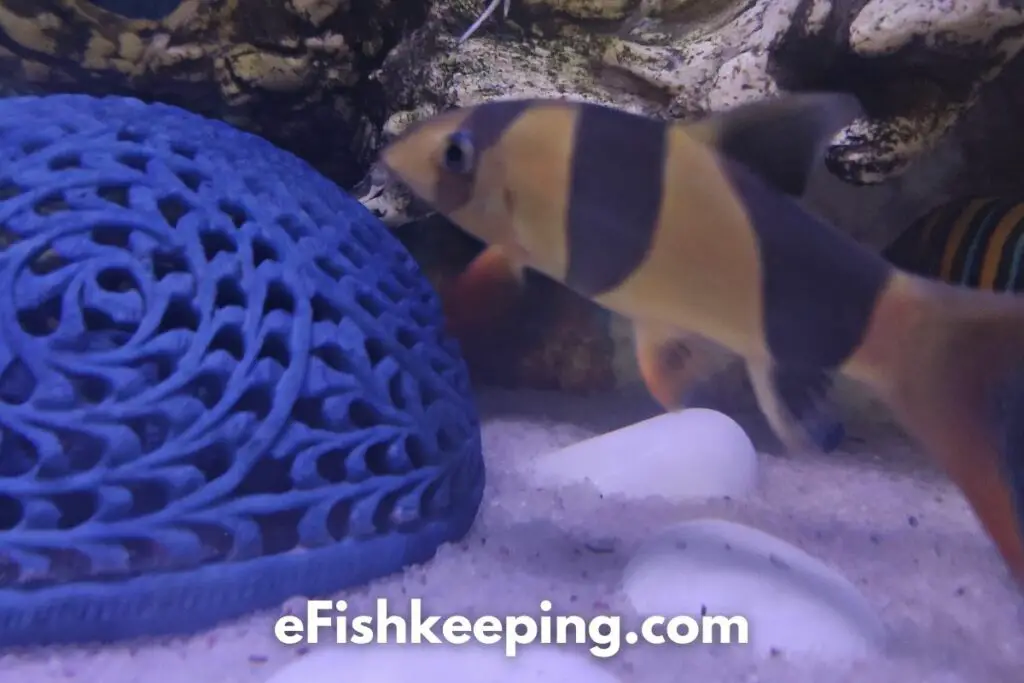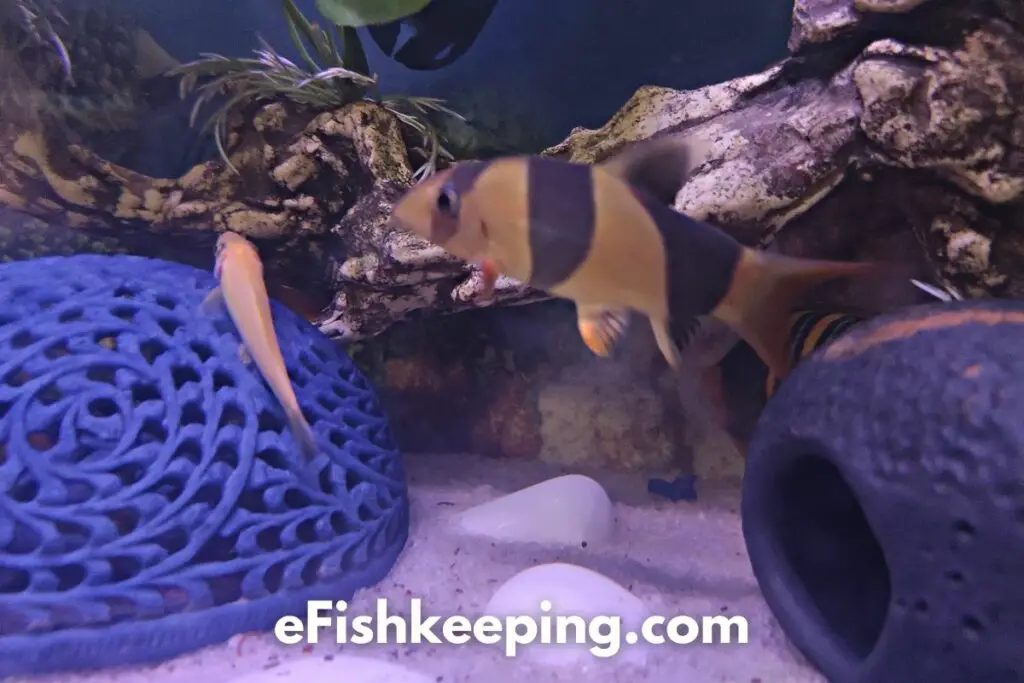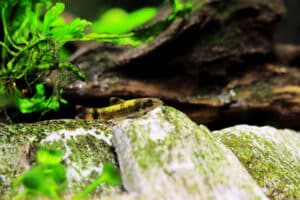I have been keeping clown loaches in my home fish tanks for quite some time now. And I love them a lot. But did you notice your clown loaches are annoying other tank mates? Or, maybe they are just fighting with each other?
Let’s take a closer look at this guide where I explain whether or not clown loaches are aggressive, why they can sometimes become aggressive, and how to stop that.
Are Clown Loaches Aggressive?

As a general rule, clown loaches are not aggressive; instead, they are shy, peaceful, and quite active fish. However, you may notice some form of aggression in clown loaches, like curiously inspecting the other tank mates with their barbels which is not harmful in most cases.
In the fishkeeping hobby, clown loaches are considered peaceful freshwater fish. And being an owner of three clown loaches and keeping them for quite some time now, I can say that is true in most parts, without any doubt.
Personally, I have kept my clown loaches with different tank mates.
- In my relatively big cichlid tank, I have kept them with blood parrot cichlids, firemouth cichlid, and others, but had no problem.
- In my second, relatively medium-sized tank, I have kept the clown loach with zebra Danios, Denison Barbs, and others. But again, I didn’t have any problem at all.
Because of their usual shy nature and bottom-dwelling behavior, they rarely come in the way of other fish. I have never seen them heavily attacking any fish.
Why Is Your Clown Loach Becoming Aggressive?

Now, if you have searched about the clown loach aggression and came here, then it is likely you are already suspecting your clown loach to be aggressive.
Clown loaches are known to be peaceful fish and coexist with almost any tankmate. The most common reason your clown loach is becoming aggressive is their curiosity towards other tank mates or their natural behavior of establishing hierarchy in the tank.
#1. The Behavior of Slightly Tinkling Other Fish
Did you recently introduce a new fish in your tank? Then your clown loach may be just curious to move around that fish.
It may seem like your clown loach is sniffing the new tank mate as a cute pup would do with a new house member. Or maybe, the clown loach is doing it for fun to tease the other fish a bit.
Remember that clown loaches are pretty active fish.
Although they can be shy at times, generally speaking, if they feel confident enough, they won’t hesitate to look around and investigate different things in the tank. In this process, they may swim around at times and peck at other fish.
But in almost all the cases, this act is never harmful. Usually, you won’t notice any significant injury in your fish. And if you do see, then it is wise to separate the fish immediately. Or try out some other ways to reduce the aggression.
Ahead in this guide, I have shared some of the ways you can reduce the aggressive behavior of clown loach. So keep reading till the end to learn more.
#2. Establishing Hierarchy In The Tank
Another reason your clown loach can become aggressive, especially with other clown loach fish is their behavior of establishing a hierarchy in the tank.
In simple words, hierarchy is a system in which the members of the group are ranked based on their relative status or authority.
If you have recently got some clown loaches, you will notice the behavior of establishing a hierarchy (pecking order) among the loaches in the tank.
In biology, the dominance hierarchy is also known as the pecking order. So to understand it, let’s take the example of chickens.
In A barnyard, the chickens tend to peck at those they think have lower status. And they receive the pecks from the ones that are dominant than them.

As a result, it is ultimately observed that the chicken at the top of the pecking order is generally the dominant one and has perfect feathers.
The one that suffered the most (e.g., with missing feathers from its neck) is usually at the lower end of the pecking order. The pecking order is also observed with fish.
In the case of clown loaches, as you might have guessed already, the required hierarchy is established through fights and dominance. So if your clown loaches are fighting with each other, it is mainly because of this behavior.

It can be challenging for you to look at your clown loaches fighting and showing aggression. But in general, it is good to leave them as it is and let them set up the pecking order on their own.
Let nature do its job and the aggression will hopefully go away after some time. (Of course, if you are noticing severe damage among your clown loaches, you can interrupt and take some steps to save your fish.)
How To Stop Aggressive Behavior Of Clown Loaches?
#1. Rearrange The Tank Decorations
Suppose your clown loaches are constantly fighting over dominance and hierarchy issues in the tank. Then, you can re-arrange all the tank decorations like the caves, rocks, and driftwood in a different location.
So the next time you put the clown loaches in, they will most likely forget about the fighting. Instead, their focus will move away from the hierarchy established in the tank, thus reducing aggression.
Related Guide: Do Clown Loaches Eat Algae?
#2. Add More Hiding Places
Take a look at your tank carefully. Do you think all your clown loaches have enough places to hide or rest? If the answer is no then why not add more hiding places?
You can include anything like a cave or driftwood as a hiding place.
For instance, one of my clown loach spents most of its time resting in a cave decoration. Another two spent most of their time under the space of driftwood or somewhere near the rocks.

Fun Fact: Clown loaches do play dead which is quite fun to look at as you can see in the above image. (Play dead simply means lying on the back and pretending to be dead.) Clown loaches typically lay on their sides while resting.
So don’t get scared if you notice that with yours! A slight tapping on tank glass would reveal that the clown loach is fully active and alive!
Hiding places will allow your clown loaches to feel safe and secure. The bullied clown loach can easily take shelter in a hiding spot whenever a fight occurs. In addition, the caves, rocks, and driftwood add a sort of visual break in the tank system.
So the chances of interaction between the dominant and the less dominant clown loaches decreases. As a result, a calm environment in the tank can be developed with very few chances of aggression.
#3. Add More Clown Loaches And Expand The School
Another way you can reduce the aggression and fights in clown loaches is by adding more fish of their kind.
Clown loaches are active and social fish that like to live in schools. Therefore, as a general rule, you should keep them in a group of at least five.
Adding more clown loaches to the tank will help spread out the dominance and aggression among the fish.
To observe the most natural behavior of your clown loaches, aim to keep at least 3 of them. Of course, more is better if your tank allows, as clown loach prefers to live in a 10-15 fish group.
#4. Ensure Clown Loach Have Enough Space Relative To Their Size
Clown loaches can grow as big as 12 inches. However, most clown loaches we buy from pet stores are juveniles or babies. The size of juvenile clown loaches is roughly about 2-3 inches in length.
So observe your clown loaches. Depending on their size, you should have enough space for them in the tank. So either you need to free up the space in your tank, or you need to get a bigger tank.
As I highlighted, aggression can occur in clown loaches to establish the hierarchy in the tank. The dominant fish will always try to display its dominance over the lower-status fish.
If you have a relatively small tank, then the dominant fish will always get triggered and feel the fight challenge coming from the less dominant fish. Because of lack of space, the less dominant fish might not be able to maintain the required distance from the dominant fish.
Buying an appropriately sized tank should give them enough space to live well. Thus, it will also reduce the aggression in the tank among the fish and they will likely stop fighting.
The adult size of a clown loach generally ranges from 5.9-7.9 in. And as a general rule of thumb, for 1 adult clown loach, you would need at least 30 gallons.
You can calculate the required tank size based on that number. So for instance, if you have 5 adult-size clown loaches, you would need about a 150-gallon tank.
For a group of juvenile clown loaches, you should at least choose a 75-gallon tank.
Do you already have a 125-gallon tank but cannot decide how many clown loaches you need for it? Then check out my guide: How many clown loaches do you need for a 125-gallon tank? To get a detailed answer!
Final Thoughts
In short, clown loaches are pretty calm and active. However, at times they can get aggressive towards each other because of the pecking order, which should subside on its own after some time. Also, keeping them with other tank mates is safe because they don’t do any harm in most cases.
If you notice the aggression, you can follow the steps we discussed in this guide.
And if you are deciding to have a clown loach as a tank mate, then you can go for it with complete confidence. They are the bottom-dwelling fish, and only occasionally would they come across the way of the other fishes in the tank.
Just give them the right conditions to live in, and you can spend a long time with these awesome buddies that can last for up to 10 years or even more!
Recommended Reading:
Hi! I’m Praveen Ghoshal, the founder of eFishkeeping.com. Inspired by my Dad, I got interested in fishkeeping when I was a kid. Since then, I have been involved with this hobby. Currently, I have 3 fish tanks at our home, and I enjoy this hobby with my full family. Read more about me here.





![Do Neon Tetras Die Easily? [Here’s The Truth!] do-neon-tetras-die-easily](https://efishkeeping.com/wp-content/uploads/2023/03/do-neon-tetras-die-easily-300x200.jpg)


